
"Starting next summer, the Independent System Operator anticipates its reliability margins in New York City will be dangerously thin, making the grid more vulnerable to failures. In addition to potentially losing anticipated wind power, the system is strained by generator deactivations, increasing consumer demand, transmission limitations and difficulties in developing new resources, the ISO said in a statement highlighting a pair of reliability reports."
"The ISO's Short-Term Assessment of Reliability examined the five-year period from July 2025 to July 2030 and identified reliability weaknesses beginning in New York City in 2026, in Long Island in 2027 and in the Lower Hudson Valley region in 2030. The New York City area will be deficient "through the entire five-year horizon without the completion and energization of future planned projects," the STAR report concluded."
"Those projects include the 816-MW Empire Wind offshore project, which was expected to be online by 2027. That timeline was complicated when the Trump administration halted the project in April before allowing it to resume a month later. Since then, it has faced additional complications and delays."
The Independent System Operator projects thin reliability margins beginning next summer in New York City, with capacity weaknesses emerging in Long Island by 2027 and the Lower Hudson Valley by 2030. The New York City area is expected to be deficient across the entire five-year horizon without completion and energization of planned projects. System strain stems from potential loss of anticipated wind power, generator deactivations, rising consumer demand, transmission limitations and challenges developing new resources. Critical projects cited include the 816-MW Empire Wind offshore project and the 1,250-MW Champlain Hudson Power Express transmission line, both facing timeline risks and delays.
Read at Smart Cities Dive
Unable to calculate read time
Collection
[
|
...
]